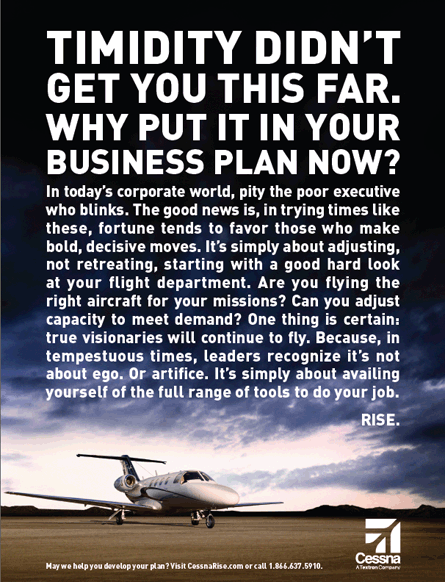Cessna is hitting back at the growing army of business aviation critics by launching a campaign designed to address what it calls "misinformation on the business use of general aviation aircraft".
The move comes after weeks of negative publicity and public vilification of the business aviation industry by newspapers and politicians alike.
The Wichita-based airframer - the world's largest manufacturer of business and general aviation aircraft - says the campaign will provide a more accurate picture of the value of business aircraft as a resource that makes companies more competitive.
"We think it's time the other side of the story be told," says Cessna chief executive Jack Pelton. "Support should be given to those businesses with the good judgement and courage to use business aviation to not only help their businesses survive the current financial crisis, but to more quickly forge a path toward an economic upturn."
 |
|---|
© Cessna |
He says that while business leaders and managers are encouraged "to work at their absolute peak to turn their companies, and our economy, around, business aviation provides the means to do just that. A business aircraft is a tool of industry, and one that should see its highest and best use during times of fiscal crisis. Anyone who has ever seen managers board a business aircraft at dawn and return well after dark, having visited multiple cities and attended countless meetings in one day can attest to the fact that business aviation allows companies to get the most out of every minute of every day - exactly what is needed to work our way toward economic recovery."
Pelton says the reality of business aviation is that 85% of aircraft used by businesses are used by small or medium-sized companies, and that the large majority of the passengers are middle managers and technicians. The aircraft, for the most part, are single- and twin-engined propeller and turboprop aircraft or small or medium-sized jets.
"The reality of business aviation is a far cry from the misconception of chief executives flying in large luxurious airplanes," Pelton says. "Most of these aircraft are fairly Spartan, designed for business, with a cabin about the size of a minivan or SUV interior."
Cessna's campaign will begin with advertisements with pro-business themes encouraging operators to keep flying business aircraft to demonstrate leadership in the face of economic challenge. The campaign, supported by a communications initiative, will celebrate the business person's vision and pursuit of opportunity served by the increased productivity and efficiency of business aviation.
"Importantly, general aviation's contribution to the American economy includes 1.2 million jobs in all 50 states," Pelton says. "These people produce, design, support, maintain, and/or service business aircraft either directly or through support operations at 5,000 general aviation airports."
General aviation contributes more than $150 billion annually to the US economy and is one of the few remaining industries that maintain a positive balance of trade with nearly 40% of the country's total 2007 production of $12 billion worth of aircraft exported.
Source: Flight International













